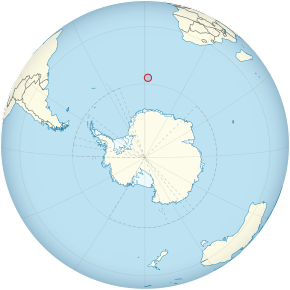
Back Bouveteiland Afrikaans Bouvetinsel ALS جزيرة بوفيه Arabic جزيرة بوڤيتويا ARZ Islla Bouvet AST Buve adası Azerbaijani Бувэ Byelorussian Бувэ (востраў) BE-X-OLD Буве Bulgarian বোভেত দ্বীপ Bengali/Bangla
Bouvet Island Bouvetøya (Norwegian) | |
|---|---|
 Location of Bouvet Island (circled in red, in the Atlantic Ocean) | |
| Country | |
| Annexed by Norway | 23 January 1928 |
| Dependency status | 27 February 1930[1] |
| Nature reserve declared | 17 December 1971[2] |
| Official languages | Norwegian |
| Government | Dependency under a constitutional monarchy |
• Monarch | Harald V |
• Administered by | Ministry of Justice and Public Security |
| Area | |
• Total | 49 km2 (19 sq mi) |
| 93% | |
| Highest elevation | 780 m (2,560 ft) |
| Population | |
• Estimate | 0 |
| ISO 3166 code | BV |
| Internet TLD | |
Bouvet Island (/ˈbuːveɪ/ BOO-vay; Norwegian: Bouvetøya[3] [bʉˈvèːœʏɑ])[4] is an island and dependency of Norway, and declared an uninhabited protected nature reserve. It is a subantarctic volcanic island, situated in the South Atlantic Ocean at the southern end of the Mid-Atlantic Ridge, and is the world's most remote island. It is not part of the southern region covered by the Antarctic Treaty System.
The island lies 1,700 km (1,100 mi) north of the Princess Astrid Coast of Queen Maud Land, Antarctica, 1,900 km (1,200 mi) east of the South Sandwich Islands, 1,845 km (1,146 mi) south of Gough Island, and 2,600 km (1,600 mi) south-southwest of the coast of South Africa. It has an area of 49 km2 (19 sq mi), 93 percent of which is covered by a glacier. The centre of the island is the ice-filled crater of an inactive volcano. Some skerries and one smaller island, Larsøya, lie along its coast. Nyrøysa, created by a rock slide in the late 1950s, is the only easy place to land and is the location of a weather station.
The island was first spotted on 1 January 1739 by the Frenchman Jean-Baptiste Charles Bouvet de Lozier, during a French exploration mission in the South Atlantic with the ships Aigle and Marie. They did not make landfall. He mislabeled the coordinates for the island, and it was not sighted again until 1808, when the British whaler James Lindsay encountered it and named it Lindsay Island.[5] The first claim to have landed on the island was made by the American sailor Benjamin Morrell, although this claim is disputed. In 1825, the island was claimed for the British Crown by George Norris, who named it Liverpool Island. He also reported having sighted another island nearby, which he named Thompson Island, but this was later shown to be a phantom island.
In 1927, the first Norvegia expedition landed on the island, and claimed it for Norway. At that point, the island was given its current name of Bouvet Island ("Bouvetøya" in Norwegian).[6] In 1930, following resolution of a dispute with the United Kingdom over claiming rights, it was declared a Norwegian dependency. In 1971, it was designated a nature reserve.
- ^ Cite error: The named reference
LOV19300227was invoked but never defined (see the help page). - ^ Cite error: The named reference
FOR19711217was invoked but never defined (see the help page). - ^ Cite error: The named reference
polar-stadnamn-Bouvetøyawas invoked but never defined (see the help page). - ^ Cite error: The named reference
Berulfsen-1969was invoked but never defined (see the help page). - ^ Cite error: The named reference
Mills-2003-1-96was invoked but never defined (see the help page). - ^ Cite error: The named reference
wordpress-abandoned-lifeboatwas invoked but never defined (see the help page).
Cite error: There are <ref group=lower-alpha> tags or {{efn}} templates on this page, but the references will not show without a {{reflist|group=lower-alpha}} template or {{notelist}} template (see the help page).